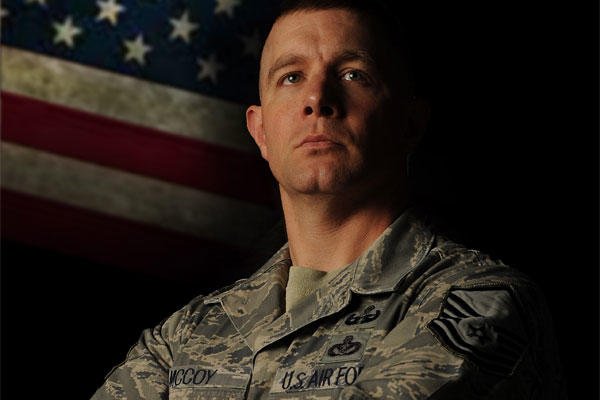MINOT AIR FORCE BASE, N.D. -- Thirteen years, 19,000 missions in Afghanistan, 36,000 in Iraq -- and now the last of the Air Force explosive ordnance disposal units are finally home.
Among the returnees was three-time bronze star recipient Master Sgt. John McCoy, the 5th Bomb Wing EOD flight chief.
McCoy is a member of the last six Air Force EOD flights to return, but he wasn't just over there to see the curtain fall. While McCoy helped pack up and turn off the lights, he was also there at the very beginning to watch the EOD mission in Afghanistan take shape.
"In 2001 you were in a sleeping bag in a hangar with a pallet of MREs and water," he said, reflecting on how the mission has developed over time. "Now it's flat screens and air conditioning."
With the last units finally out, for many service members this is the end of an era.
"You can kind of see the generations of equipment," he said. "We started pulling stuff out, and it was like 'Yeah, I remember when they sent these over.'"
McCoy made it clear that while the withdrawal might have brought a sense of relief, it's been a long road, wrought with dangerous moments along the way.
"(Once) I looked down, and it was a Yugoslavian landmine," McCoy recalled. "It was fused, and it had a tripwire. I looked at the tripwire, and it went to another landmine, and that had a tripwire, so I was in the middle of basically a field of tripwires and live landmines. I was about sixty or seventy yards into the minefield."
The incident, in McCoys words, seemed no more than another day at the office. McCoy said he believes the most dangerous element is the unknown, and that discipline and a focus on safety are vital.
"A lot of times we'll get a call like, 'Suspicious item alongside the road, wires protruding.' And that's it," McCoy said. "That's all we have to go on, disturbed earth and some wires. That could be anything. There's a lot of inherent hazard, but we try to keep it as safe as possible."
Thirteen years of EOD operations have come with a high price. Twenty EOD Airmen have been killed in theater since 9/11, and more than 115 EOD have been wounded.
"There is such a thing as doing all the right steps and still getting hurt," McCoy said. "You can still get in trouble even if you're doing the right thing, because a lot of what we deal with is not standard, it's improvised."
McCoy explained that despite the human cost to the EOD mission, the Airmen's work is crucial to ground operations.
"Every time we go out and reduce a hazard, it potentially saves lives, saves equipment. It prevents a chain of other things from happening, because we're dealing with the incident in the safest way possible," McCoy said. "Every time you deal with an (improvised explosive device), you think that could have been someone's leg, or that was two guys that didn't get blown up."
Though this mission is now complete, McCoy knows there will always be more for EOD to do. Dealing with IEDs and repurposed ordnance was the focus in Iraq and Afghanistan, but that's only a small portion of EOD's overall mission. Every device that's successfully disposed of is a potential tragedy averted, and EOD Airmen put their lives on the line to prevent those tragedies.
Each device carries risk but also a potential reward, McCoy said.
"Each one is someone who's not going to have to get slung out of here in a helicopter, or even die," he added.





























